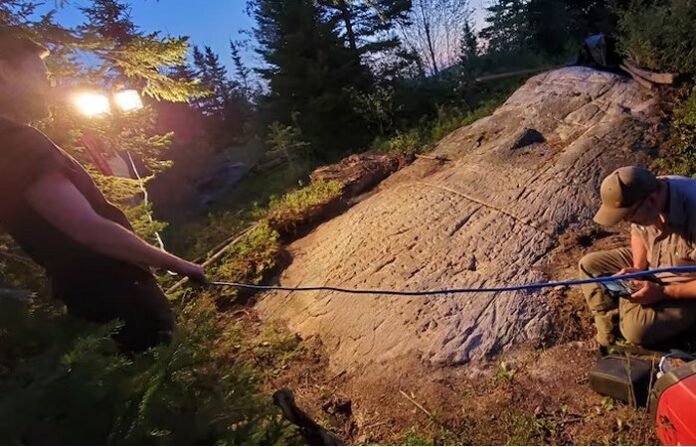Jan Bartek – AncientPages.com – The discovery of a mysterious runestone in Ontario, Canada, has sparked significant interest and provided new insights into an intriguing archaeological puzzle. This journey began seven years ago when a fallen tree in the northern Ontario bush revealed a stone inscribed with runes.
Located near Wawa, the stone features 255 symbols arranged in a square measuring approximately 1.2 by 1.5 meters, alongside an image of a boat carrying 16 people and accompanied by 14 Xs.
David Gadzala and Ryan Primrose, directors of the Ontario Centre for Archaeological Education, have been conducting a seven-year study on a Nordic runestone carved into the bedrock in northern Ontario near Wawa. Their research aims to uncover insights into this intriguing artifact’s origins and historical significance. Credit: Ryan Primrose
The Ontario Centre for Archaeological Research and Education (OCARE) was alerted to this potential find by a local historian from Wawa. Ryan Primrose, an archaeologist from New Liskeard and director at OCARE, received photographs of the site. In October 2018, initial research and site visits suggested that the carvings were likely inscriptions written in futhark characters—a runic script historically used across northern Europe and Scandinavia. Adjacent to these inscriptions is another carving depicting what appears to be a Viking longboat with about 16 figures on board, surrounded by several crosses or stars.
Wawa runestone. Credit: OCARE
To further investigate these findings, OCARE consulted an epigrapher from Finland who directed them to Henrik Williams, an emeritus professor at Uppsala University in Sweden and a leading expert in runology. The primary questions revolved around identifying who created these carvings, deciphering their meanings, and understanding why they were placed at this specific location. After years of study and collaboration among experts worldwide, we now have some answers to these compelling questions.
Primrose, who began working on the carvings in 2018, is now discussing them publicly for the first time. “We didn’t want to release information publicly until we had done as much as we could at the time to understand exactly what it was,” he told CBC in an interview.
Primrose quickly identified the 255 characters as Nordic runes, part of the Futhark alphabet used in Scandinavia centuries ago. Upon visiting the site and examining the stone, it was confirmed that the inscription was genuinely runic. However, it was neither Viking-related nor a fabrication. Dr. Williams explained that these deeply carved runes represent a Swedish-language version of the Lord’s Prayer. The text corresponds to the Swedish version of this prayer from the 16th century and is written using a variation of Johannes Bureus’s runic translation developed in the early 17th century.
“It must have taken days of work. They are deeply carved into the rock. Someone probably spent weeks carving this. And this must have been a Swede. Were there any Swedes here at all?” Dr. Williams said.
The 250 runic characters etched into the rock form the text of the Lord’s Prayer. It is thought that these inscriptions were created in the early 1800s and subsequently buried. They remained hidden until a tree fell in 2018, revealing them once more. Credit: Ryan Primrose
Primrose has explained that further research reveals the Hudson’s Bay Company employed Swedes during the 1800s to work at trading posts in the Canadian wilderness, such as the Michipicoten post, which is near where the carving was discovered. Based on its level of wear, his current hypothesis suggests that this carving was likely created in the early to mid-1800s.
Dr.Williams admits to being “a little disappointed” that it’s only about 200 years old, but says “the mystery around it doesn’t decrease just because it’s slightly younger than we hoped it was.”
“Anybody has to start wondering ‘Why on Earth did they carve it here and why did they choose that text?’ And there’s no answers,” he said.
“But mysteries, they do tend to attract people and this one will certainly do that.”
Primrose suggests that this carving might have served as a site for religious worship, potentially a meeting place for Swedes associated with the trading post, or perhaps it was created by an individual. The carving was discovered beneath several inches of soil, indicating it may have been intentionally buried. However, the absence of additional artifacts in the vicinity makes it challenging to determine its exact purpose.
See also: More Archaeology News
In collaboration with the property owner, Primrose has applied for a lease on the land and is seeking funding to transform the site into a historical tourist attraction. Plans include constructing a protective structure over the carving to prevent further deterioration. He aims to finalize these plans by the end of summer and subsequently offer visitors the opportunity to explore and contemplate this enigmatic carving firsthand.
Written by Jan Bartek – AncientPages.com Staff Writer









